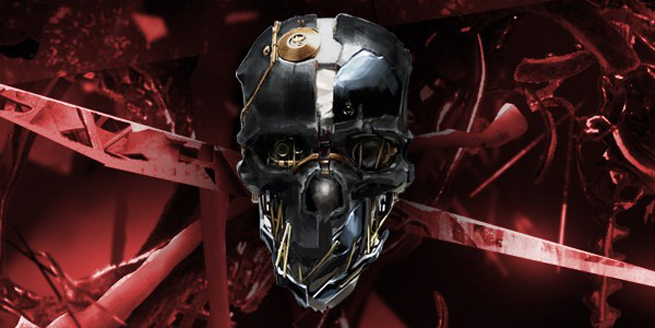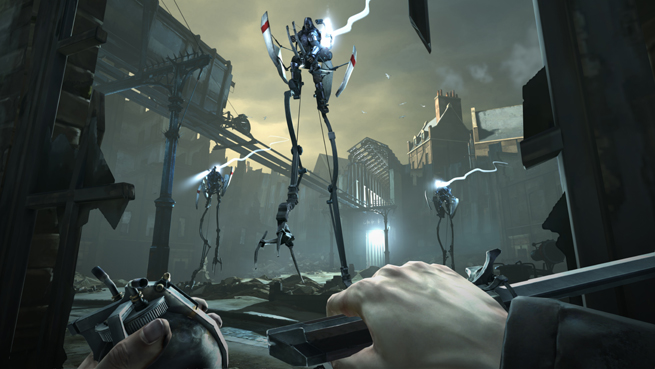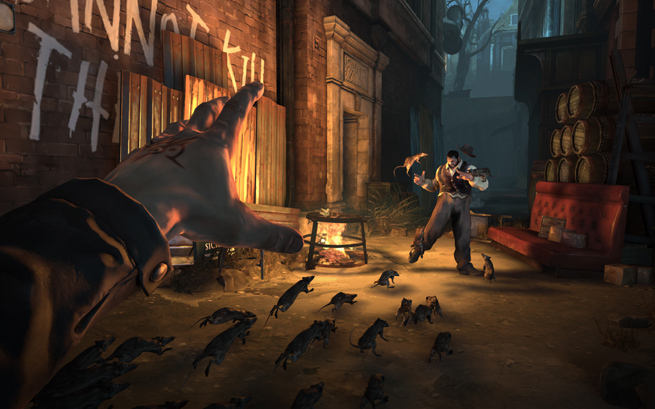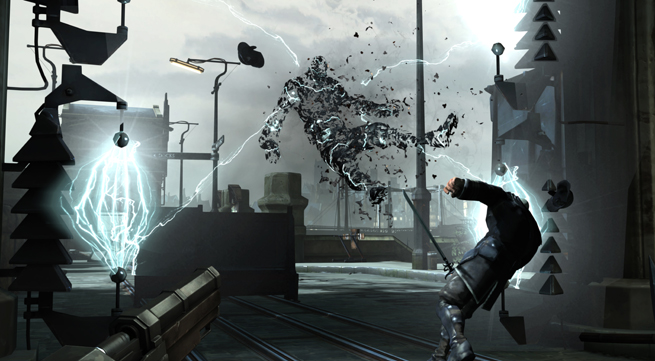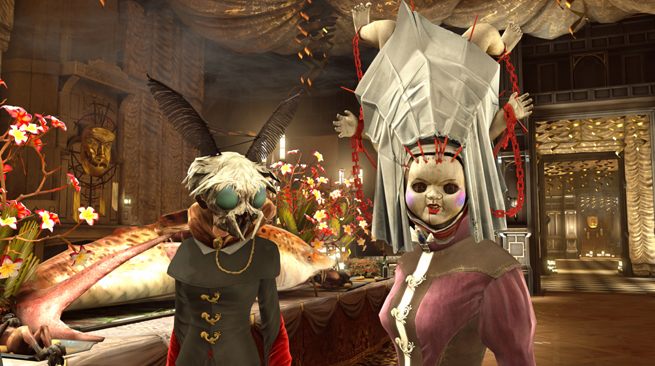It’s rare to see something put the “punk” in “steampunk” as thoroughly as Dishonored does. Forget romanticism … the game’s fictional Empire of the Isles feels like it’s dangling over a cliff. Its high art and technological wonders both stem from the same delusional madman. A rat-borne plague has decimated the crumbling capital city of Dunwall. Corruption at every level is a given. When the Empress Jessamine Kaldwin reaches out to foreign powers for help, her own top advisers finish her off in a swift, bloody coup d’état.
And you? You’re Corvo Attano, the suddenly unemployed Lord Protector framed for her murder by its conspirators. Clearly, that’s not acceptable.
Luckily, loyalists engineer Corvo’s escape and a mysterious, omnipotent being known as the Outsider — i.e. Satan, according to the local religion — grants him astounding supernatural powers with which to rescue the kidnapped Emily Kaldwin, young heiress to the throne, and to dispatch the traitors who stole her crown. How you do it is entirely your choice.
That’s where Dishonored (available October 9 on Xbox 360, PlayStation 3, and PC) shines brightest, proudly reviving the first-person stealth genre and giving it a nicely twisted edge … even if a few flat notes keep it from true greatness.
WHAT YOU’LL LIKE
It takes a Thief: The Dark Project
Take the benchmark stealth gameplay from the Thief series, add the two-pronged weapon/power combo from atmospheric shooter BioShock, shake in a dash of Hitman’s silent assassination, and set it in 19th century Eastern Europe by way of Nicola Tesla. That’s Dishonored. But developer Arkane Studios didn’t just pick stellar influences (and wisely hire Harvey Smith, Thief’s lead designer, as a creative director). They mixed those elements into a seriously potent dish where every weapon, device, ability, and play style complements the others.
Well, eventually. Maybe it’s just been a while, but Dishonored’s brand of first-person sneaking takes getting used to. Keep Corvo’s body out of view, and you’re hidden regardless of any line-of-sight issues. Expect to lean out from cover a lot when you’re not looking straight through it with your x-ray Dark Vision. Distance and light factor in, too, but I’m pleased to report you’re never fully invisible. Pistol-packing officers and Overseer zealots always see you coming much sooner than their more careless subordinates, and Tallboys — heavily armed and armored sentries on robotic stilts — don’t miss a thing.
Once you dial into those nuances, Dishonored falls into place. Purchase and upgrade a few powers via collectable runes, and you can avoid or dismantle threats with near impunity. I frequently used Blink, a super-dash ability, to instantly zip up to unsuspecting enemies and kill/disable them before they even knew it.
Fortunately, Dishonored features some of the most careful balancing I’ve seen lately, making you feel like a total badass without ever breaking the game. Block-and-slash swordplay makes up the bulk of close combat — pleasantly tactile even if enemies occasionally rake you from 10 feet away — while everything else (gadgets, ranged weapons, supernatural abilities) maps to Corvo’s left hand. You can only equip one at a time. Resource drains keep the really dark magic in check, but even better, calling up the power-selection wheel doesn’t pause the game. If you don’t manage your hotkeys accordingly, the City Watch will chop you like month-old lettuce while you’re screwing around equipping your deployable rat swarm. And believe me, guards love to sound the alarm, call in reinforcements, and take you apart en masse.
So just like Thief, stepping lightly, staying out of sight, and planning your moves are the best strategies. Pick a fight on impulse, and you’re likely a goner. Not that you have to pick a fight at all, because ….
The gameplay options are astounding
While trapped on the wrong side of an electrified barrier, a quick glance around gave me a wealth of choices. Possess a nearby rat and scamper through a grate to the other side. Take control of a human soldier and walk right on through unharmed. Cut down the squad watching the barrier’s power source and steal the battery. Or do it when the guards weren’t looking.
Dishonored plays exactly the way you want to play it. Sneaky. Violent. Merciful. Mischievous. Malevolent. Expansive levels give you options a’plenty, and every problem comes with at least three or four solutions … or more, depending on which powers you’ve unlocked. Your supernatural arsenal tends to skew toward distraction, evasion, and infiltration, but you’ll find offensive uses for them as well. Why not freeze time, snap a few crossbow bolts into a few faces, attach a spring-razor mine to another enemy, then wind-blast him into a crowd of soldiers so they’re all shredded when time speeds up again? Yep, you can do that.
You can also finish the game without killing anyone, not even the targets your loyalist allies want eliminated, though the fates you arrange for your victims are arguably crueler than a swift blade to the chest. Or, like me, you can go around booby-trapping security devices to vaporize soldiers instead of Corvo, then stepping out into view so they unwittingly run straight into the kill zone. I have to say, the survivors wise up pretty fast.
So skulk around in sneak mode, take to the rooftops, find secret paths and hidden rooms, or simply assassinate everyone you meet and feed the bodies to the rodent hordes infesting the city. Any way you roll, Dishonored’s good with your decisions.
[vb_gallery id=546744]
World building at the end of the world
The proud, decaying city of Dunwall might just be the most fully realized fantasy-game world since Rapture, BioShock’s underwater dystopia. Cool period flourishes blend seamlessly into postindustrial bleakness. You get a very real sense that a golden age recently gave way to the elements, to apathy, to plague, to unscrupulous science and black magic skulking in dark alleys. Dishonored’s visuals sometime look a bit too flat, and more than a few animations clip in reliably cheap ways (especially the ever-present rats), but the art direction wins out.
Arkane squeezes a lot of variety out of its setting, too. In addition to several fortresses, Corvo visits rotting slums run by warring gangs, attends a high-society costume ball in a spectacular mansion (the only mission where he can walk around freely without the City Watch pouncing), and travels into quarantine zones where Weapers — mindlessly hostile plague victims — roam the streets. Because, hey, what’s a video game without zombies nowadays?
You’ll find all the lore-hound favorites (notes, books, and audio logs) to fill out Dunwall and its whale-based economy. But Dishonored’s secret weapon is the Heart, a bio-mechanical organ/divining rod. When it’s not pointing you straight to every upgrade rune and stat-boosting Bone Charm, the Heart provides great insight into the world around you. Point it at people and it tells you their past and their future. Rarely does it say anything cheerful; “Unless he dies tonight, he will kill twice more before taking his own life” captures the essence of the Heart’s commentary pretty well. It’s even more instructive when you use it on your loyalist allies.
The Heart is easily my favorite character in the entire game. And that’s where we start getting into some of Dishonored’s bigger flaws.
WHAT YOU WON’T LIKE
The marketing tells a better story than the game does
Silent protagonists have an important place in video games. Dishonored isn’t that place. When you push a story charged with highly personal motives like revenge, it helps if someone actually feels that bloodthirsty rage. I don’t, and neither does blank-slate Corvo, no matter how many times other characters insist he does. Considering how they also tell Corvo how awesome he is every chance they get, he doesn’t seem particularly dishonored either, despite both his rather glaring failure to save the Empress and the game’s very title.
But then, you’ll find plot holes just about everywhere you look, and no points for guessing the late-game twist; it’s telegraphed early and often. The Outsider exists mainly as an empty contrivance to give you superpowers and make snarky observations to the point where you’ll eagerly wait for your chance to take a shot at him (spoiler: it never comes). The Empress’ mysterious killers have powers similar to Corvo’s, but they show up as complete question marks and vanish with few explanations given. With few exceptions, using the Heart reveals the rich inner lives of soldiers, politicians, nannies, boatmen, servants, scientists, witches, and criminals far more than anything those people say or do.
None of this hurts gameplay, of course, but it’s still a major disconnect from what’s going on around you. In fact, Corvo seems more interested in saving young Emily Kaldwin from the power struggles of old white men than he is in destroying those men’s lives. We get interesting hints as to why, and then the plot drops the subject. Too bad, because nailing the story aspect might’ve made Dishonored a home run.
[vb_gallery id=546495]
Limited gameplay options
Dishonored plays out across nine levels in seven environments (some featuring multiple maps), including the Hound Pits Pub, the loyalist hideout and game hub where Corvo hangs out between assassinations. I’m not entirely sure why this game needs a hub, but it’s got one. And while you can go anywhere and do anything in those open environments, you won’t find all that much to do.
Outside of patrols and occasional Weepers, Dunwall’s sparsely populated due to the plague. You might find abandoned or boarded-up apartments with a treasure-trove of goodies inside, but forget scooping up miniquests, Grand Theft Auto/Assassin’s Creed-style. Each level features one beefy main mission and one side mission, tops. More often, Dishonored relies on you to hunt for upgrades, or it hands you one quick, optional task to accomplish (save a friend’s cousin from being poisoned, kill your former torturer, and so on) since you’ve already snuck into the general vicinity anyway. More exploration won’t turn up any extras. Dishonored clearly signposts all of its content.
And no, not every level is a winner. You’ll find a long, uneven clunker right toward the end, and the short wrap-up level after it almost comes across as an apology.
That said, I’m already rerunning a few other levels to try different things, and exploring those possibilities makes up a lot of the stealth genre’s entertainment value. But without an exhaustive approach like that, the replayability is low, low, low. Sans multiplayer, a co-op mode, or even a “new-game plus” feature to carry your hard-won upgrades over to a fresh playthrough, a competent person should blow through Dishonored in one dedicated weekend. And that’s it.
The payoffs don’t pay well
I dealt with the final target in one shot. Not even a headshot. Tagged him in the shoulder, I believe. Bit of a letdown, that.
But for a game that emphasizes choice above all else, it’s pretty light on consequences. Dishonored even warns you up front that a nonviolent approach offers more long-term benefits while bathing in the blood of your enemies changes how people treat you, adds more Weepers down the road, and generally steers Dunwall toward the end times. To be sure, you can earn a fairly apocalyptic final cut-scene, but the game’s very structure doesn’t allow it to make good on its threats more than once or twice. Other decisions don’t carry much impact, either. Asked to choose between two feuding allies boils down to whether you get more power upgrades or more weapon upgrades. Not exactly a dramatic gut-punch.
I actually like how forgiving the system is. In the interest of science, I merrily slaughtered my way through a few levels, slipped through others undetected, and played a mix (fighting only when discovered) the rest of the way. That approach still netted me a low-chaos score and the “best” ending. But even though I feel my soul is clean, I get the nagging sense I should’ve paid a heavier toll for my outrages. C’mon, “low chaos?” I just reduced half the constabulary to ashes and decapitated a horde of supernatural assassins! What’s it gonna take?
CONCLUSION
Dishonored nails the Thief-style gameplay while missing the BioShock-quality story that would’ve elevated it into something truly special. It’ll have to settle for amazingly cool instead. The impressive depth, range, and balance earn this one an easy recommendation despite a few hiccups and one dreary, excessively long level. Gamers who don’t feel the need for repeat plays might not get their money’s worth, but for me, one spin through Dunwall wasn’t enough. The care and imagination that went into Dishonored makes each return visit worthwhile.
Score: 86/100
Dishonored releases October 9, 2012 for the PlayStation 3, Xbox 360, and PC. The publisher provided GamesBeat with a PlayStation 3 copy of the game for the purpose of this review.
VentureBeat's mission is to be a digital town square for technical decision-makers to gain knowledge about transformative enterprise technology and transact. Learn More
